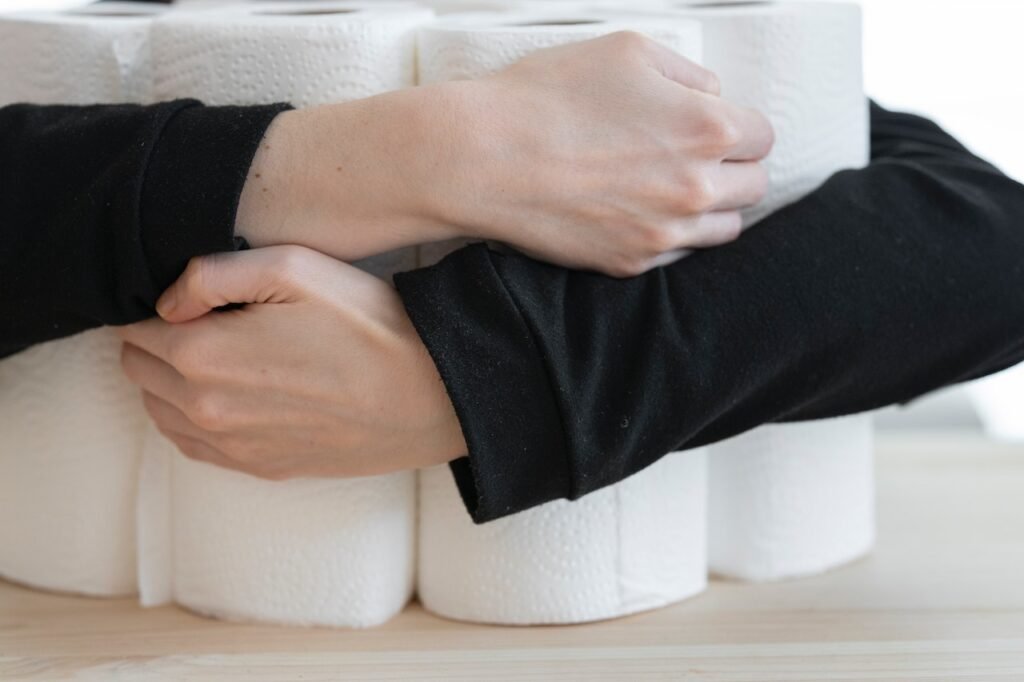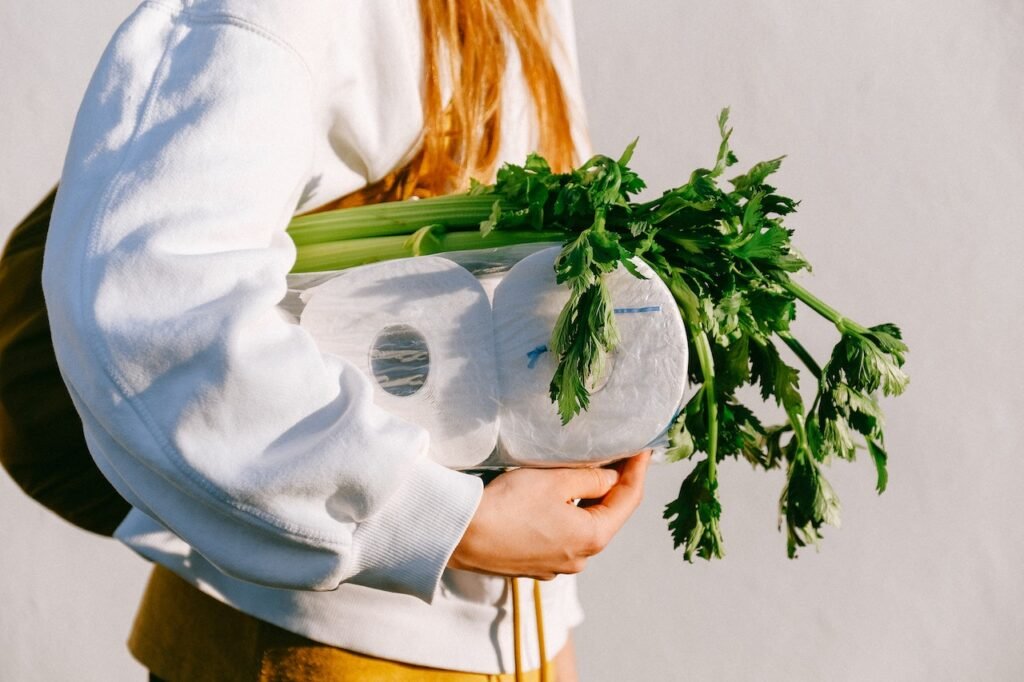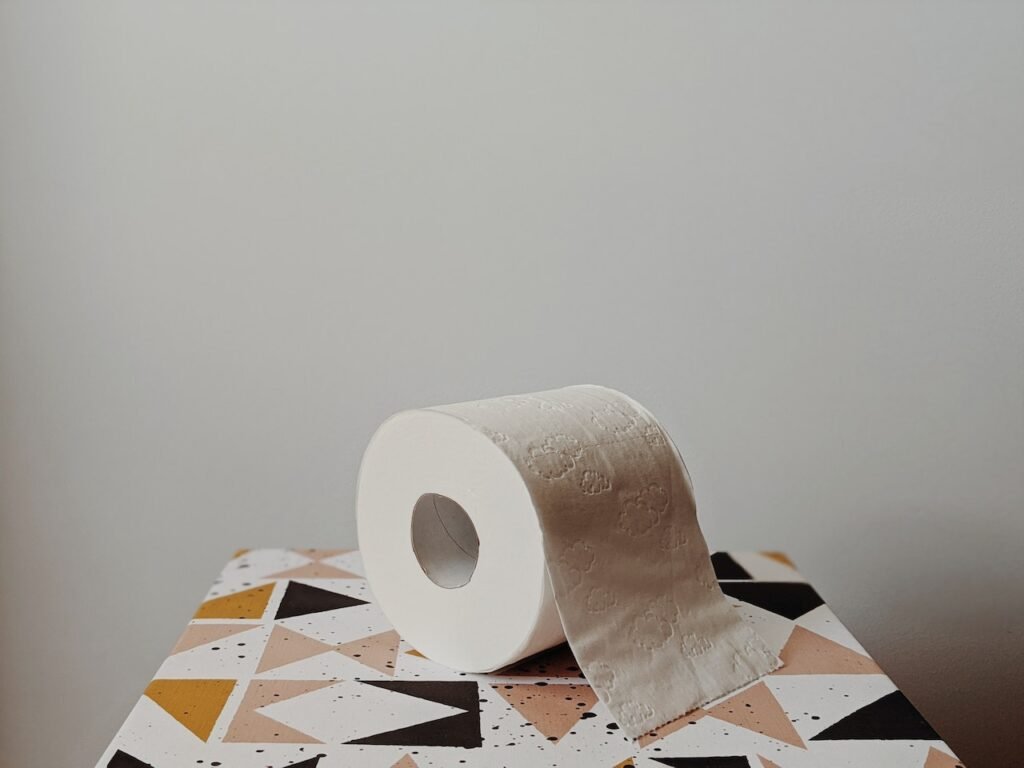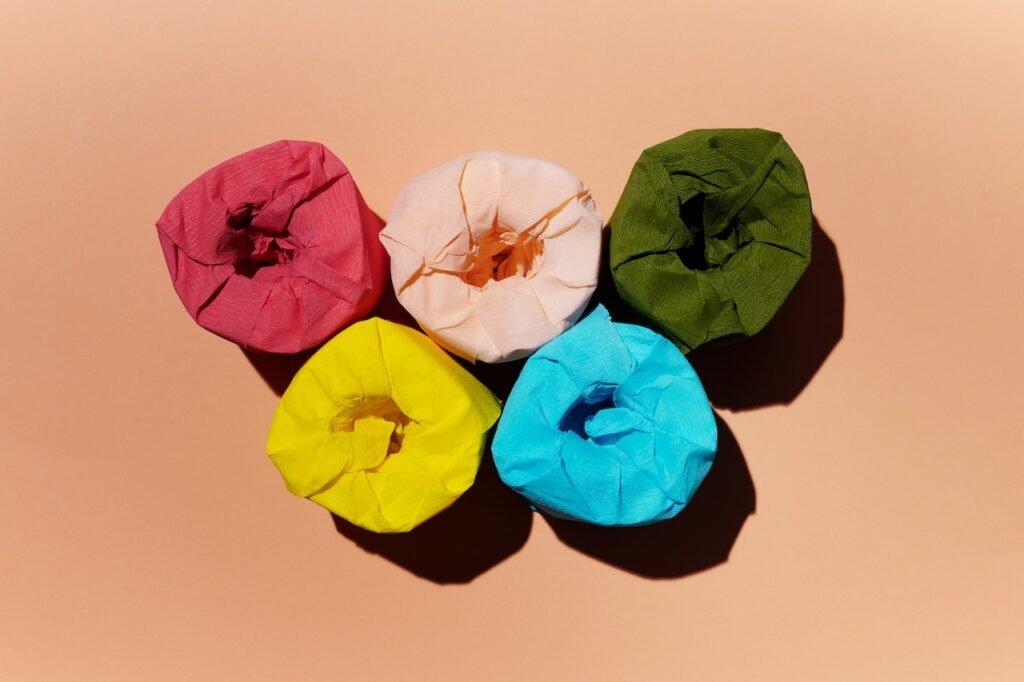Guide on How Is Bamboo Toilet Paper Made
0Shares
How can a piece of tough bamboo become soft, opulent 3-ply toilet paper? Below is a brief explanation of the manufacturing process for bamboo toilet paper. People typically associate bamboo with tough grass sticks that pandas nibble on all day while anxiously making jokes about the potential of getting shrapnel in their buttocks from using bamboo toilet paper. Nonetheless, the topic of precisely how a piece of bamboo’s rigid constitution is changed into soft and opulent 3-ply toilet paper persists.
We have the option of using bamboo toilet paper, recyclable toilet paper, or ordinary toilet paper made from trees. We are curious as to how a plant like bamboo gets changed into the soft and sturdy bamboo toilet paper that all of us enjoy, even though bamboo toilet paper is recognized as being ecologically beneficial. It’s important to comprehend how bamboo toilet paper is made since it varies from conventional toilet paper in several unique ways.
The environmental impact of our home may be significantly reduced by using bamboo toilet paper, and that impact grows over time. This is a brief explanation of the process of making bamboo toilet paper.
What is Bamboo Toilet Paper?
Traditional toilet paper may be replaced with bamboo toilet paper. It is constructed from the rapidly expanding bamboo plant, as the name would imply. Although bamboo is legally a grass-based paper because of this, it has characteristics more related to hardwoods like oak and maple, both of which are frequently combined with softwoods (like pine) to produce standard toilet rolls.
Moso Bamboo, the type of bamboo used to create Good Toilet Paper, is cultivated in Guizhou, China, in which the factory also is located. Guizhou’s border mountains have been designated as one of China’s eight plant diversity hotspots. The principal vegetation types include everlasting broad-leaved forests, coniferous & broad-leaved mix forests, montane elfin forests, and a lot of bamboos. This implies that our bamboo is not cultivated on deforested land, as it has done for thousands of years.
How Bamboo Toilet Paper Made

Toilet paper Although toilet paper is a basic home necessity, we rarely give it much thought daily (unless there is a global shortage). Of course, toilet paper hasn’t always been used for human waste disposal.
The common bathroom essential was created by American Joseph Gayetty, who deserves credit. The “therapeutic paper” he invented in 1857, flat pieces of paper covered in aloe, was a failure. Yet ten years later, three brothers found the perfect marketing mix, and the Scott Paper Company popularized toilet paper. During Gayetty’s time, not much changed in the production of toilet paper. Both back then and today, it was created from trees. Let’s quickly examine how it’s done and the reasons why better, more environmentally friendly choices are required.
🧤Growing Bamboo
Growing bamboo is the initial stage in the production of bamboo toilet paper. Bamboo grows quite quickly. It has also been reported that some bamboo species may grow taller than 4 feet in a single day. This implies that we could observe bamboo growth in real time if we were standing in a bamboo forest. Compared to trees, which can mature anywhere from Ten to 120 years, this is a lot quicker. This implies that we may plant bamboo crops with confidence that we can swiftly harvest them.
Moreover, compared to an identical tree mass, bamboo generates 35% more oxygen. Additionally, farmers may harvest bamboo in a method that allows them to work with the local ecology rather than against it. Bamboo naturally resists insects, therefore using pesticides is not necessary while cultivating it. Moreover, bamboo may be grown in a way that reduces deforestation. Bamboo has fewer negative impacts on our rivers and does not damage our water tables since it takes less water & irrigation to flourish.
Raising bamboo is generally more sustainable and ecologically benign than growing many other crops. Additionally, because it is a plant that can be harvested repeatedly, it spares farmers the need to grow into environmentally sensitive areas by giving them a reliable and constant source of income. Contrary to how what is frequently the case with trees, farmers are not required to keep expanding their areas under cultivation to prosper.
🧤Producing Toilet Paper
Without the utilization of chemicals, the bamboo plant is chopped into small pieces & pulped using a combination of heat and water. Following that, it is washed & bleached using chlorine-free or hydrogen-peroxide techniques. It has now transformed into bamboo pulp, which may be used to make toilet paper.
If we had ever attempted to make handmade paper, the procedure would be comparable. In a paper machine, fiber and water are mixed, flattened, dry, and divided into sheets & rolls.
Bamboo Toilet Paper Compare to Other Toilet Paper
🔸Regular Toilet Paper
Bamboo toilet paper is ecologically good since it is biodegradable, renewable, and durable. The toilet paper we just flushed down the drain, on the other hand, is frequently composed of virgin pulp, which implies that trees are chopped down to manufacture it. This implies that using normal toilet paper might harm the environment by causing deforestation and other issues. In many circumstances, bamboo toilet paper is even softer and stronger than ordinary paper. So, there is no justification for down trees just to make toilet paper.
🔸Seek Bamboo Toilet Paper
The toilet paper from Seek Bamboo is also more environmentally friendly than reused toilet paper. The recycled paper must first undergo chemical breakdown before being bleached and converted into toilet paper. One of the substances of concern found in residues on recycled toilet paper is bisphenol-A or BPA. Heart illness, endocrine problems, and reproductive problems have all been linked to BPA exposure.
Halogenated hydrocarbons have also been shown to be present in recycled toilet paper. These chlorinated substances are known to cause cancer and harm the environment. In contrast, no harsh chemicals are used in the production of toilet paper manufactured from bamboo.
When deciding what sort of toilet paper for using, it is crucial to investigate how toilet paper is created to properly comprehend its environmental impact. We discover that bamboo toilet paper is a great option for all of our toilet paper requirements after learning more about how it is produced. Finding little modifications that might have a significant impact on the environment is becoming more and more crucial as we all become much more aware of how our households affect the environment. As a consequence, bamboo toilet paper is the appropriate solution for the majority of our residences.
Eco-Friendly Bamboo Toilet Paper

Usually speaking, bamboo goods are among the greenest ones available. Not only are they composed of sustainable materials, yet they break down totally and swiftly, as well. Bamboo tissue is not any different. Thus, if you’re asking if bamboo toilet paper is environmentally friendly, the answer is unquestionable yes. Bamboo is a naturally robust and soft material that is also renewable. Because of its adaptability and capacity to regenerate, bamboo goods have a significantly lower negative influence on the environment.
👉Strong and Soft Material
Emerging eco-friendly construction material is bamboo. Bamboo is the choice material for a variety of items, from home décor and clothes to chopping boards and guitars, since it can be used to create things that are wonderfully soft as well as incredibly durable. Because bamboo is so soft, we utilize it to make the opulent furnishings that many of us use in the two rooms that contemporary society regards as being the most sacred, the bedroom and, of course, the bathroom.
Bamboo toilet paper, robes, and bedding have all gained popularity for their softness and tenacity. You might be shocked to find that the same material that goes into making your softest sheets is frequently utilized in furniture production as well as large-scale building projects. Research has shown that bamboo is a more durable and adaptable building material than steel, concrete, or even wood.
As a result, bamboo is increasingly popular as an earthquake-resistant material. The small portions and rings that divide them are what make the bamboo plant so hardy. Even the early Chinese military used design cues from the plant when constructing bulkheads to divide spaces on their ships. Ships became more robust and less likely to sink as a result.
👉Renewable Resource
Bamboo is a naturally abundant material that may be used again and over again. Bamboo has already been growing throughout Southeast Asia for a long time. Even now, you may still find native bamboo trees in several regions of South America and the US.
Because it grows everywhere, bamboo is not just a renewable resource. Instead, the fact that bamboo is so abundantly renewable is to blame. Bamboo seems to be the fastest-growing plant on earth and may grow up to 35 inches each day or 1.5 inches every hour.
Bamboo can be replanted right away since it grows so fast after being consumed. As a consequence, the bamboo population may simply be managed to minimize overconsumption. Eco-friendly materials like bamboo may be used to create any kind of product. Bamboo creates superior toilet paper because it is both robust and soft, as well as extremely renewable.
Bamboo Toilet Paper Breakdown
Many environmentally concerned shoppers are interested in learning how bamboo toilet paper truly decomposes. It seems to sense that they are aware of the impact toilet paper has on their plumbing as well as the environment.
👉Bamboo Toilet Paper In Pipes
We frequently flush things down the toilet that don’t break down, such as towels, wipes, and tiny toys, clogging the toilet & backing up lines. All of the plumbing inside the house might be impacted by clogged pipes, which is troublesome if you have a septic tank.
Regrettably, toilet paper may also jam pipes. Too much bath tissue or bath tissue that is too thick might quickly clog the drain and give you a headache. Many consumers will use cheap one-ply toilet paper to save the additional plumbing expenditures. So, think about a less unpleasant option before going for what seems like dollar-store sandpaper.
How septic-safe is bamboo toilet paper? Yes! The septic tank and bathroom experience are improved by utilizing bamboo toilet paper. Bamboo toilet paper is sturdy (and soft) enough to be used and simply decomposes in water. This makes the toilet paper septic safe since water will be able to flow freely through the pipes without being backed up by clumps of toilet paper.
👉Bamboo Toilet Paper to Environment
Every roll of toilet paper will ultimately degrade. Glass bottles will also ultimately decompose, albeit it may take a million years, according to BBC Science Focus. Although it will degrade more quickly than conventional toilet paper, it may still take many years.
Bamboo goods, on the other hand, degrade far more quickly. As an illustration, Mable creates a durable bamboo toothbrush that is designed to last for around 3 to 4 months. When a toothbrush is no longer effective, the user only needs to remove the bristles and throw the brush onto their compost bin.
Finally, I would say yes. Generally, bamboo toilet paper decomposes considerably more effectively than regular, even recycled, toilet paper. A thin sheet of bamboo toilet paper will quickly and organically degrade, much like a bamboo toothbrush, leaving no evidence of its existence either on the earth or in your pipes.
Things to Know About Bamboo Toilet Paper

You undoubtedly started looking around during the Great Toilet Paper Shortage to see if there were any choices available – at all, anywhere. Also, you could have discovered bamboo toilet paper throughout your search. The following information regarding bamboo toilet paper is important.
☑️Sustainably Grown Bamboo
Bamboo may expand up to 3 feet (0.9 meters) every day. While trees may take 50 years or more, it takes only three years for them to be ready for harvest. Compared to toilet paper made from trees, bamboo toilet paper emits at least 30% fewer greenhouse gases while it is growing.
By doing so, water is conserved and there is no need to feed the soil with chemicals. Technically speaking, bamboo is grass, not a tree. In essence, these businesses are mowing a forest rather than very tall grass. When it comes to toilet paper, speed is crucial. On average, Americans consume 57 squares daily, which equates to 50 pounds (23 kg) of toilet paper annually.
☑️Bamboo Processing Doesn’t Need Chemicals
Several chemically demanding conversion techniques for bamboo used in textiles and non-wovens have been covered in the media. As those goods require a spinnable fiber, the manufacturing procedure is quite different and significantly depends on the chemical breakdown of the fibers. Unfortunately, we do not have to deal with the issues that result from this concerning the use and disposal of chemicals. Instead of utilizing chemicals to break down the bamboo’s fibers, Who Gives a Damn pulverizes and heats the material.
☑️Bamboo Toilet Paper Is Safe
It could even be safer than toilet paper made from trees. In addition to decomposing, it is also biodegradable and, as we previously said, doesn’t contain the same nasty chemicals as regular toilet paper. Make sure the bamboo toilet paper you purchase hasn’t been bleached to earn additional green points.
Because bamboo toilet paper is so durable, it frequently employs one or two plies rather than the luxurious three plies seen in high-end plant paper, though three plies are still an option. Bamboo may also be used in toilets since it decomposes more readily than toilet paper with more layers.
☑️Most Bamboo Is Grown in Asia
They mentioned that the bamboo farms used for toilet paper are FSC-certified, indicating that the bamboo forests are being properly managed for the sake of the environment and the local people. As a result, local woods as well as the wildlife that inhabits them are less affected.
Benefits of Using Bamboo Toilet Paper

Because of its possible environmental advantages, bamboo toilet paper has grown in popularity in recent years. The following are some of the advantages of using bamboo toilet paper:
🧻️Sustainability
Bamboo is a rapidly growing, renewable resource that may be collected without causing harm to the plant or the environment. This makes it a more environmentally friendly alternative than typical wood pulp toilet paper.
🧻️Softness
Regular toilet paper, which may be harsh and abrasive, is typically considered gentler and more pleasant than bamboo toilet paper.
🧻️Strength
Since bamboo strands are tougher than wood pulp fibers, bamboo toilet paper is less prone to shred or break during usage.
🧻️Antibacterial
Bamboo includes a natural antibacterial ingredient known as “bamboo kun,” which helps to inhibit bacteria development and decrease odor.
🧻️Biodegradability
Bamboo toilet paper was biodegradable and degrades faster than standard toilet paper, which is sometimes constructed of non-biodegradable materials.
🧻️Hypoallergenic
Bamboo is inherently hypoallergenic, which means it is less likely than ordinary toilet paper to cause skin problems or allergic responses.
Overall, bamboo toilet paper has several potential environmental and personal comfort and health benefits.
Bamboo Toilet Paper Is Better Than Ordinary

“Is bamboo toilet paper truly that much superior to regular?” you may still be asking. “After all, it is the major question. The quick answer is yes, certainly. Bamboo toilet paper trumps all other toilet paper alternatives. Bamboo outperforms both recycled and virgin pulp bath tissue. Recycled toilet paper is the least soft. Bamboo toilet paper & virgin toilet paper, on the other hand, are neck and neck softest. Bamboo toilet paper is soft and thick, providing maximum comfort and absorbency.
In terms of eco-friendliness, bamboo toilet paper & 100 percent recycled toilet paper outperform 30% to 40% recycled paper. Virgin toilet paper is a distant third. The plant itself is what gives bamboo the edge in terms of environmental friendliness. Bamboo is a completely renewable material that grows rapidly, takes up little land, and requires no fertilizers and pesticides to thrive.
The pricing is going to be the most important customer issue. The price of a product will ultimately influence whether or not it is purchased. Although virgin toilet paper is often the least expensive, consumers may also get recycled & bamboo toilet paper at reasonable pricing.
Frequently Asked Questions
What are the disadvantages of using bamboo toilet paper?
The disadvantage of bamboo toilet paper is that it is frequently more expensive than typical toilet paper manufactured from trees. Bamboo toilet paper degrades slower than recycled paper, so it might not be the greatest option if you want a biodegradable solution.
Is bamboo toilet paper pricey?
In many situations, eco-friendly items that are compatible with your sustainable lifestyle are more expensive than their dollar-store equivalents. Without a doubt, bamboo toilet paper is more costly than standard tree-based goods.
Is bamboo toilet paper chemically treated?
Producing bamboo toilet paper is comparable to starting using logged trees, only the initial raw material is bamboo. The bamboo is chopped into small pieces and pulped using a combination of heat and water (without chemicals!).
Is bamboo toilet paper good for your skin?
Although recycled toilet tissue is soft and absorbent, bamboo toilet tissue provides additional skin advantages such as being anti-bacterial, anti-fungal, odor-resistant, and ultra absorbent. Additionally, for those wondering how it compared to quality tissue products, it’s just as soft.
Where does bamboo toilet paper come from?
Yet, there are some concerns, such as the possibility of forests being chopped down to make a bamboo place. Because the plant, which is categorized as grass, does not grow well in North America, the majority of the pulp and goods are imported from Asia.
Is bamboo toilet paper allergy-friendly?
Bamboo toilet paper is naturally hypoallergenic, and the bulk of it is lint-free and fragrance-free. This makes our products ideal for persons with sensitive skin or ladies who experience irritation after wiping.
Final Thoughts
Anybody considering a more eco-friendly lifestyle may consider replacing their standard toilet tissue with bamboo bathroom tissue. Generally, bamboo toilet paper is extremely soft and sturdy, but it degrades quickly after use so quickly that you should never have to worry about a clogged pipe and septic system again.
Bamboo toilet paper is good for the environment, our wallets, and even our bottoms, but it’s not for everyone. You have the power to pick the correct paper for your lifestyle & make the greatest option for you and your family if you do your study and learn about bamboo & bamboo toilet paper. Do you want to know how to wash bamboo utensils? Click Here!
0Shares
